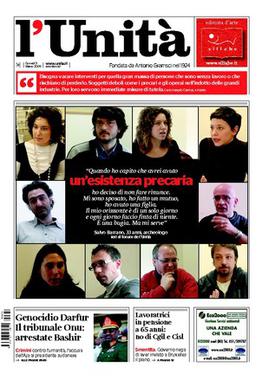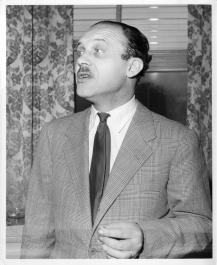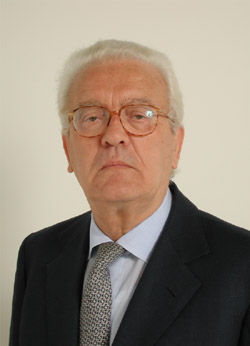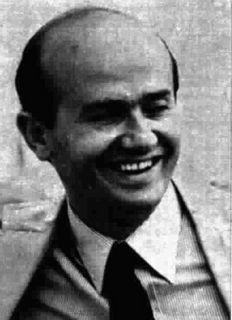
Corriere della Sera is an Italian daily newspaper published in Milan with an average circulation of 246,278 copies in May 2023. First published on 5 March 1876, Corriere della Sera is one of Italy's oldest newspapers and is Italy's most read newspaper. Its masthead has remained unchanged since its first edition in 1876. It reached a circulation of over 1 million under editor and co-owner Luigi Albertini between 1900 and 1925. He was a strong opponent of socialism, clericalism, and Giovanni Giolitti, who was willing to compromise with those forces during his time as prime minister of Italy. Albertini's opposition to the Italian fascist regime forced the other co-owners to oust him in 1925.

la Repubblica is an Italian daily general-interest newspaper with an average circulation of 151,309 copies in May 2023. It was founded in 1976 in Rome by Gruppo Editoriale L'Espresso and led by Eugenio Scalfari, Carlo Caracciolo, and Arnoldo Mondadori Editore as a leftist newspaper, which proclaimed itself a "newspaper-party". During the early years of la Repubblica, its political views and readership ranged from the reformist left to the extraparliamentary left. Into the 21st century, it is identified with centre-left politics, and was known for its anti-Berlusconism, and Silvio Berlusconi's personal scorn for the paper.

l'Unità is an Italian newspaper, founded as the official newspaper of the Italian Communist Party (PCI) in 1924. It was supportive of that party's successor parties, the Democratic Party of the Left, Democrats of the Left, and, from October 2007 until its closure in 2017, the Democratic Party.
il Giornale, known from its founding in 1974 until 1983 as il Giornale nuovo, is an Italian-language daily newspaper published in Milan with an average circulation of 28,933 copies in May 2023. In 2006, it was considered one of Italy's main national newspapers in Italy.

Luigi Albertini was an influential Italian newspaper editor, member of the Italian Parliament, and historian of the First World War. As editor of one of Italy's best-known newspapers, Corriere della Sera of Milan, he was a champion of liberalism. He was a vigorous opponent of socialism and clericalism, and of Giovanni Giolitti who was willing to compromise with those forces during his time as prime minister of Italy. Albertini's opposition to the Italian fascist regime forced the owners to fire him in 1925.
Il Popolo d'Italia was an Italian newspaper published from 15 November 1914 until 24 July 1943. It was founded by Benito Mussolini as a pro-war newspaper during World War I, and it later became the main newspaper of the Fascist movement in Italy after the war. It published editions every day with the exception of Mondays.

The People of Freedom was a centre-right political party in Italy. The PdL launched by Silvio Berlusconi as an electoral list, including Forza Italia and National Alliance, on 27 February for the 2008 Italian general election. The list was later transformed into a party during a party congress on 27–29 March 2009. The party's leading members included Angelino Alfano, Renato Schifani, Renato Brunetta, Roberto Formigoni, Maurizio Sacconi, Maurizio Gasparri, Mariastella Gelmini, Antonio Martino, Giancarlo Galan, Maurizio Lupi, Gaetano Quagliariello, Daniela Santanchè, Sandro Bondi, and Raffaele Fitto.

The Agenzia Nazionale Stampa Associata is the leading news agency in Italy and one of the top ranking in the world. ANSA is a not-for-profit cooperative, whose members and owners are 36 leading news organizations in Italy.

The Right was a neofascist and national-conservative political party in Italy. Its founder and leader was Francesco Storace.

Corrado Alvaro was an Italian journalist and writer of novels, short stories, screenplays and plays. He often used the verismo style to describe the hopeless poverty in his native Calabria. His first success was Gente in Aspromonte, which examined the exploitation of rural peasants by greedy landowners in Calabria, and is considered by many critics to be his masterpiece.

Future and Freedom, whose full name was Future and Freedom for Italy, was a political party in Italy, comprising both liberal and national conservative elements.
Secolo d'Italia is a daily online newspaper in Italy, published since 1952, formerly supporting neo-fascism. In 2012, it ceased its print edition and continued as an online-only conservative publication.

L'Ora was a Sicilian daily newspaper published in Palermo. The paper was founded in 1900 and stopped being published in 1992. In the 1950s–1980s the paper was known for its investigative reporting about the Sicilian Mafia.

Guido Piovene was an Italian writer and journalist.
La Notte was an Italian afternoon newspaper published in Milan between 1952 and 1995.
Mario Cervi was an Italian essayist and journalist.

Egidio Sterpa was an Italian journalist and politician.

Roberto Gervaso was an Italian writer and journalist. He won the Premio Bancarella twice: for L'Italia dei Comuni in 1967, and for Cagliostro in 1973.












